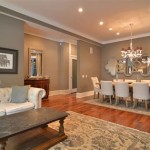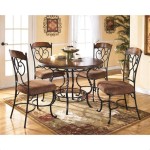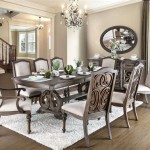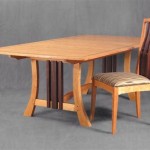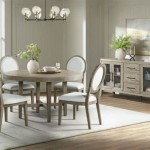Accent Wall Colors For Dining Room: A Comprehensive Guide
The dining room, traditionally a space for sustenance and social interaction, is often overlooked in the broader scheme of interior design. However, a well-designed dining room can significantly enhance the dining experience, fostering a more inviting and enjoyable atmosphere. One of the most effective and relatively inexpensive ways to dramatically transform a dining room is through the strategic use of an accent wall. An accent wall, painted a color different from the remaining walls, serves as a focal point, drawing the eye and adding depth, character, and personality to the space. Selecting the right color for an accent wall in the dining room requires careful consideration of various factors, including the existing color palette, the room's lighting, the size of the space, and the desired aesthetic.
The primary purpose of an accent wall is to create visual interest and break the monotony of a single color scheme. It can also be used to highlight architectural features, such as a fireplace or a large window, or to complement existing furniture and decor. The choice of color for the accent wall should be deliberate, reflecting the desired mood and style. A poorly chosen color can create a jarring effect, detracting from the overall ambiance of the room. Therefore, understanding the principles of color theory and the psychological effects of different colors is crucial in making an informed decision.
Understanding the Role of Color Psychology in Dining Room Design
Color psychology suggests that different colors can evoke specific emotions and influence behavior. This is particularly relevant in the dining room, where the atmosphere directly impacts the dining experience. For example, warm colors like red, orange, and yellow are often associated with energy, warmth, and appetite stimulation. Conversely, cool colors like blue, green, and purple tend to promote calmness and relaxation. The use of these colors in the dining room requires a balanced approach to avoid overwhelming the senses or creating an undesirable ambiance.
Red, while stimulating, can also be perceived as aggressive if used excessively. A deep, muted red or a brick red can add warmth and drama to a dining room without being overpowering. Orange, another energetic color, can create a welcoming and convivial atmosphere. A burnt orange or a terracotta shade can be particularly effective in adding warmth and earthiness to the space. Yellow, the color of sunshine, promotes happiness and optimism. A soft, buttery yellow can brighten up a dining room and create a cheerful ambiance. However, it's important to avoid overly bright or harsh yellows, which can be visually jarring.
Cool colors, on the other hand, can create a more serene and sophisticated dining experience. Blue, often associated with tranquility and stability, can be a good choice for a formal dining room. A navy blue or a slate blue can add a touch of elegance and sophistication. Green, the color of nature, promotes balance and harmony. A sage green or an olive green can create a calming and refreshing atmosphere. Purple, often associated with royalty and creativity, can add a touch of luxury and drama to a dining room. A deep plum or a lavender shade can be particularly effective in creating a sophisticated and inviting space. Neutral colors like gray, beige, and white can serve as a versatile backdrop for an accent wall, allowing other colors and textures to take center stage.
The key is to consider the overall desired mood and style of the dining room when selecting an accent wall color. If the goal is to create a vibrant and energetic space, warm colors might be a better choice. If the goal is to create a more relaxing and sophisticated space, cool colors or neutral tones might be more appropriate. Balancing the intensity and saturation of the chosen color is also important to avoid creating a visually overwhelming or uninviting atmosphere.
Factors Influencing the Optimal Accent Wall Color Choice
Beyond color psychology, several practical considerations influence the optimal accent wall color choice for a dining room. These include the room's lighting conditions, the size and shape of the room, the existing color palette, and the style of the furniture and decor. Ignoring these factors can lead to a color choice that clashes with the overall aesthetic or creates an undesirable visual effect.
Lighting plays a crucial role in how colors are perceived. Natural light tends to enhance the vibrancy of colors, while artificial light can alter their appearance. A color that looks stunning in natural light might appear dull or washed out under artificial light. Therefore, it's important to test color samples in different lighting conditions before making a final decision. If the dining room receives ample natural light, darker and more saturated colors can be used without making the space feel too closed in. If the room has limited natural light, lighter and brighter colors can help to brighten up the space and create a more airy and welcoming atmosphere.
The size and shape of the dining room also influence the perception of color. Dark colors tend to make a space feel smaller, while light colors tend to make it feel larger. In a small dining room, it's generally best to avoid dark or overly saturated colors on the accent wall, as they can make the room feel cramped and claustrophobic. Lighter colors, such as pastels or neutral tones, can help to create a sense of spaciousness. In a larger dining room, darker colors can be used to create a more intimate and cozy atmosphere. The shape of the room can also be taken into consideration when choosing the accent wall. For example, if the room is long and narrow, painting the shorter wall as an accent wall can help to visually shorten the space and create a more balanced proportion.
The existing color palette of the dining room should also be taken into consideration when choosing an accent wall color. The accent wall color should complement the existing colors and textures in the room, creating a cohesive and harmonious overall design. It's generally best to choose an accent wall color that is either a shade lighter or darker than the existing wall color, or a complementary color that contrasts with the existing colors but still creates a balanced and visually appealing effect. The style of the furniture and decor in the dining room should also be taken into consideration. The accent wall color should reflect the overall style of the room, whether it's traditional, modern, or eclectic. For example, in a traditional dining room, rich and elegant colors like burgundy, navy blue, or forest green might be appropriate. In a modern dining room, bolder and more contemporary colors like teal, mustard yellow, or charcoal gray might be a better choice.
Specific Color Recommendations and Their Corresponding Moods
Based on the principles of color psychology and the practical considerations discussed above, several specific color recommendations can be made for dining room accent walls. These recommendations are based on the desired mood and style of the dining room, as well as the lighting conditions and size of the space. However, it's important to remember that personal preferences should always be taken into account when making a final decision. These are suggestions to spark ideas and help create the most optimal space.
For a warm and inviting dining room, consider using a terracotta or burnt orange accent wall. These colors evoke feelings of warmth, comfort, and hospitality. They are particularly effective in dining rooms that receive limited natural light, as they can help to brighten up the space and create a more welcoming atmosphere. These colors also work well with natural wood furniture and rustic decor. Another option for a warm and inviting dining room is a muted red or brick red accent wall. These colors add warmth and drama without being overpowering. They are particularly effective in dining rooms with traditional or classic decor. These colors pair well with dark wood furniture and gold accents.
For a sophisticated and elegant dining room, consider using a navy blue or slate blue accent wall. These colors evoke feelings of tranquility, stability, and refinement. They are particularly effective in formal dining rooms or dining rooms with a coastal theme. These colors pair well with white or light-colored furniture and silver accents. Another option for a sophisticated and elegant dining room is a deep plum or lavender accent wall. These colors add a touch of luxury and drama. They are particularly effective in dining rooms with modern or eclectic decor. These colors pair well with black or dark wood furniture and metallic accents.
For a calming and refreshing dining room, consider using a sage green or olive green accent wall. These colors evoke feelings of nature, balance, and harmony. They are particularly effective in dining rooms with ample natural light. These colors pair well with natural wood furniture and botanical prints. Another option for a calming and refreshing dining room is a soft gray or beige accent wall. These neutral colors provide a versatile backdrop for other colors and textures. They are particularly effective in small dining rooms, as they can help to create a sense of spaciousness. These colors pair well with a wide range of furniture styles and decor accents.
Ultimately, the best accent wall color for a dining room is the one that best reflects the individual's personal style and preferences. By considering the principles of color psychology, the practical considerations discussed above, and the specific color recommendations provided, one can create a dining room that is both visually appealing and emotionally satisfying.

Dining Room Paint Colors To Try Now Clare

How To Create A Dining Room Accent Wall Home Texture

40 Best Dining Room Paint Colors Color Schemes For Rooms
:max_bytes(150000):strip_icc()/MaryPatton_May2020-6-8e9f410c0f1d4fe28484853ea47b1d5c.jpg?strip=all)
40 Perfect Dining Room Colors For Any Style

12 Dining Room Accent Wall Ideas Cornerstone Remodeling

Accent Walls Done Right In Your Dining Room Olive Opal Interiors

Choosing The Ideal Accent Wall Color For Your Dining Room Decoist

Accent Walls Done Right In Your Dining Room Olive Opal Interiors

8 Beautiful Dining Room Paint Ideas Paintzen

Dining Room Wall Painting Ideas For Your Home Designcafe


